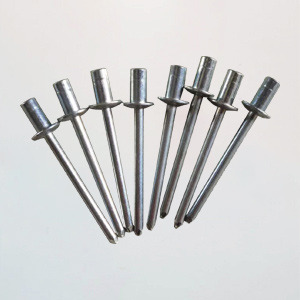Different types of rivets are suitable for different occasions. The rivet is a type of rivet used for single-sided riveting, but a special tool - a riveting gun (manual, electric, pneumatic) must be used for riveting. When riveting, the rivet core is made of a special The rivet qiang is pulled to expand the rivet body and achieve the riveting effect. This type of rivet is especially suitable for riveting situations where it is inconvenient to use ordinary rivets (riveting must be done from two sides), so it is widely used in construction, cars, ships, aircraft, On machines, electrical appliances, furniture and other products. Among them, the open-type oblate head rivets are widely used, the countersunk head rivets are suitable for riveting occasions that require smooth performance, and the automotive blind rivets are suitable for applications that require higher loads and have certain sealing properties. riveting situations.
The heat treatment of core blind rivets is an important process in determining the quality of high-strength core blind rivets. High-strength core blind rivets are quenched intermittently in a salt bath furnace or roller hearth furnace after being cooled or hot and rolled. If heat treatment is used to improve its strength and hardness, then the quenching temperature is generally guaranteed to be 800-9009C, and the tempering temperature should be controlled at 350-6501C depending on the characteristics of the steel type. If the tempering temperature is well controlled, the tempering temperature can be increased. Its influence on the hysteresis fracture strength, and at the same time ensuring the tensile strength of blind rivet products, is necessary to make it meet the design requirements. In order to ensure the uniformity of heat treatment, it is necessary to choose a product that does not have a lower hardness in the middle after heat treatment. There are many steel types. This is because surface decarburization of heat-treated products is an indispensable factor causing the deviation of the riveting moment coefficient, and recarburization will increase the susceptibility to delayed fracture. Therefore, double-drum blind rivets must be heated during heat treatment. There is no need to adjust the dew point in the furnace.

Related News
- Types of wire drawing rivets and anti-rust methods
- What are the functions of rivets?
- How to use blind rivets
- What is a rivet nut?
- Structure introduction and maintenance of rivet gun
- Application of Lantern Rivet Nut
- Classification and application of rivet standoffs
- The working principle and selection rules of riveting gun
- The use of rivet nuts
- Comparison of drawing rivet connection and traditional craftsmanship
- Precautions for installation and use of blind rivet nuts
- Introduction to the knowledge of lantern rivets
- Some precautions when using ring groove rivets
- Advantages of ring groove rivets
- Common knowledge about ring groove rivets
- Analysis of the basic principles of rivets
- Where do blind rivets need to be used?
- Solutions to the problem of Haima rivet caps falling off in the machinery industry
- Common knowledge about ring groove rivets
- How to use blind rivet nuts? You will know after reading this



